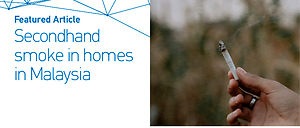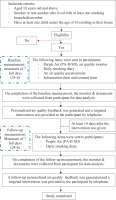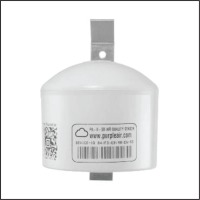INTRODUCTION
Secondhand smoke (SHS) is a serious cause of ill-health in children. SHS exposure in the young is associated with a wide range of poor health outcomes, including lower respiratory infections, asthma attacks, otitis media and severe diseases including meningitis1. These health effects are associated with a wide range of hazardous compounds present in SHS, including fine particulate matter with aerodynamic diameter of less than 2.5 microns (PM2.5). PM2.5 has been widely used as a reliable marker of the presence of SHS in indoor settings.
Malaysia is a middle-income country with a population of around 32 million. In 2019, around 21.3% of Malaysians aged ≥15 years were current smokers2 but, as in many lower- and middle-income countries at earlier stages in the tobacco epidemic3, smoking prevalence is highly gendered, with men considerably more likely to smoke (40.5%) than women (1.2%)2.
To reduce SHS exposure, the Malaysian government has introduced a range of regulations on smoking indoors in public places. Most recently, in January 2019, Malaysia implemented a comprehensive ban on smoking in restaurants, cafes and other locations where food is served4. Smoking is banned or highly restricted in many other indoor environments, such as offices, healthcare facilities and public transport (though it is still permitted in bars and nightclubs)5,6.
However, smoking within the home is still common, with a 2019 study estimating that more than half of Malaysia’s households allow smoking indoors7. As children spend the majority of their time at home, smoking indoors is likely to lead to significant exposure to SHS, particularly during recent COVID-19-related restrictions on non-essential travel. However, no studies have objectively measured SHS in Malaysian homes, meaning that health professionals, policymakers and researchers have an incomplete understanding of the scale of this problem.
An additional concern is the lack of interventions designed to reduce home smoking in the Malaysian context. Globally, a range of interventions have been developed to help parents and guardians create smoke-free homes to protect their children’s health. These have used strategies such as motivational interviewing, smoking cessation support for adults, and feedback of biomarkers of children’s exposure (such as salivary cotinine), among many other techniques8.
Interventions using air-quality feedback to engage with smokers and other family members to encourage the creation of a smoke-free home have been applied in several settings9. This approach uses low-cost air pollution monitors to measure SHS within the home over several days, and the results provided to householders along with contextual information to encourage smokers to alter their behavior. Several studies have found these interventions can lead to reductions in SHS concentrations in homes10,11, and they have been adapted for studies in the Global South12. However, most studies have been conducted in high-income countries in the Global North, without tailoring to the Malaysian social context (such as the gender disparity in smoking).
To address these issues, this research aimed to use low-cost air pollution monitors to quantify concentrations of SHS in households in Malaysia, and to explore the practicality of using the compiled information in educating Malaysian families to make their homes smoke-free.
METHODS
Study design and recruitment of participants
This was a feasibility study conducted between January and August 2021 in three areas of the Peninsula of Malaysia including Klang Valley (Selangor and Kuala Lumpur), Kuala Terengganu (Terengganu) and Kuantan (Pahang). The snowball and convenience sampling methods were adopted to recruit study participants in these selected areas. The locations were chosen because of the diversity of sociodemographic and economic status represented by all these three areas. Kuala Lumpur is a metropolitan city. Kuantan is an urban area with high economic activity, while Kuala Terengganu is a suburban area located near the east coast of Malaysia. Several recruitment strategies were applied which included:
Social media advertisement (e-poster) in the Facebook and Instagram account of the MyFamily MySmoke project and WhatsApp messages.
Distribution of posters through the post box of residents’ homes, at restaurants, shopping malls, childcare center and a local training center.
To be eligible, participants were required to be residents in one of the three areas in Klang Valley, Terengganu, or Pahang. In addition, they had to be a current smoker who smoked indoors at home or a non-smoker living with at least one smoker. An additional criterion was that at least one child under the age of 16 years resided in the participant’s home. A summary of participants’ recruitment and flow of data collection is shown in Figure 1.
Training
An online course consisted of four training sessions that were provided to the researchers. The researchers were trained in: operating the air-quality monitor using the device’s standard operating protocols; data entry to generate the air-quality feedback using a pre-defined template; and interpretation of the personalized air-quality feedback. One-to-one online training sessions were also performed to rehearse the delivery session of personalized air-quality feedback.
Data collection
Indoor PM2.5 measurement
Indoor PM2.5 concentrations were measured using a Purple Air-II-SD (PA-II-SD) (Figure 2), a real-time air-quality monitoring device. The Purple Air PA-II SD (PurpleAir LIc, Utah, USA), is a portable air-quality assessment tool that measures and records real-time PM2.5 concentrations in indoor or outdoor settings. The PA-II SD is a low-cost device (US$ 279) that uses laser particle-counters to provide real time measurement of PM1.0, PM2.5 and PM10. This device has been used worldwide including monitoring uncontrolled forest fires in California13 and as a tool to improve community engagement around air-quality issues in Western Canada14. Studies have shown that the PurpleAir performs well when compared to reference instruments14,15.
Participants were provided with the following: a PA-II-SD, a charger with micro-USB cable, a portable electric power extension socket, a small tripod and a file of documents that consisted of an information sheet with a consent form, a smoking diary, an air-quality questionnaire and a short booklet describing how to install the PA-II-SD in the home. A video to provide further guidance on assembling, connecting and installing the PA-II-SD device was also made available to all participants. Due to the global COVID-19 pandemic and the enforcement of a Movement Control Order in Malaysia, the physical visit to participants’ houses was not possible and as a result the equipment and related documents were sent to the participants using a courier delivery service.
Participants were asked to place the PA-II-SD inside the house using the following criteria: 1) the device needed to be placed in the main living area (not the kitchen); 2) ensuring a position close to an electrical power socket; 3) at least 50 cm from the floor, and at least 1m from windows or the main house entrance; and 4) avoiding any obstruction at the lower part of the PA-II-SD.
The PM2.5 concentration data were recorded on the SD card of the device every 120 seconds. Measurements were performed for a minimum of 7 full days (24-h) excluding the 1st (installation day) and 9th day (collection/return shipment day).
The time interval between baseline and follow-up measurements was set at a minimum of 14 days to allow the preparation and delivery of personalized air-quality feedback about the measured levels of SHS in the participant’s home. After completion of baseline sampling, the air-quality data were analyzed and a personalized-feedback document (Figure 3) was sent to the participants. Shortly after, participants were contacted to arrange a short (approximately 20-minute) personalized-feedback intervention call with the researcher. This session aimed to discuss the measured indoor PM2.5 concentrations and SHS exposure from the baseline sampling period and broadly followed the methods from the AFRESH intervention13,14.
Figure 3
Personalized-feedback of air quality monitoring which was sent to participants once measurements completed
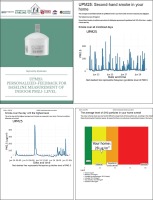
Air-quality questionnaire and smoking diary
An air-quality monitoring questionnaire was also used to gather data on: 1) sociodemographic characteristics; 2) type and house conditions; and 3) general and household smoking activities. Participants were also asked to complete daily smoking diaries to record the number of cigarettes smoked, the timing of smoking, and the specific location of smoking inside of the house. Other potential sources of PM2.5 from household activities such as cooking during the measurement were also noted in these diaries.
Educational intervention
After completion of baseline measurements, the household air-quality data were analyzed and a personalized-feedback document was sent to each participant. Shortly after, participants were contacted to arrange a short (approximately 20-minute) educational intervention call with the researcher. Generally, the session included an explanation and discussion of: 1) personalized air-quality feedback; 2) facts on secondhand smoke (SHS) organized into three topic areas ‘What is SHS?’, ‘Why is SHS dangerous?’ and ‘Why are children particularly vulnerable to SHS?’; 3) the harmful effects of SHS on children’s health; and 4) the availability of the government’s smoking cessation service. The personalized air-quality feedback included information on the average and the highest level of PM2.5 during the measurement period, a graph showing temporal changes in PM2.5 concentration over the 7-days of measurement, and a color-scheme figure showing the characterization of respondents’ home indoor air quality based on the United States Environmental Protection Agency (US EPA) air-quality guidance levels. Each of the respondents received two sessions: the first after completion of baseline measurements and the second on completion of the follow-up measurements. All these broadly followed the methods from the AFRESH intervention16,17.
Respondents were given a token of appreciation for their participation in this study. They received a small sum of 75 MYR (17.66 US$) cash, upon completion of measurements and the intervention.
Data analysis
Summary statistics were generated in Microsoft Excel to compute average values of daily, hourly and period of PM2.5 concentrations, as well as the frequency distribution of measured values by PM2.5 thresholds (Supplementary file Table 1). The data recovery rate was calculated as the percentage number of hours for which PM2.5 data were logged during the study period divided by the maximum potential number of hours based on the device sampling rate.
Outdoor PM2.5 concentration
To assess the outdoor concentration of PM2.5, the researchers obtained the hourly Air Pollutant Index (API) data from the Department of Environment (DOE) Malaysia for the sites closest to the participants’ homes for the period 1 January 2021 to 31 October 2021. The DOE indicated that the dominant air pollutant at these particular sites throughout sampling periods was PM2.5. Therefore, the API value was converted to produce the hourly outdoor air PM2.5 concentration on the dates when in-home measurements took place. The API value breakpoints and the equations used to back-calculate the outdoor PM2.5 concentrations were stated in the DOE’s website18.
RESULTS
Sociodemographic and smoking characteristics
Initially, 36 participants were recruited (Klang Valley 12; Terengganu 12; Pahang 12). Eight dropped out at various stages of the project: seven after completing the baseline measurements and one due to moving home. In total, 27 participants completed the measurement and intervention cycle in three sampling locations: 1) Klang Valley (n=7; participant IDs UPM18 – UPM30), 2) Terengganu (n=10; UMT06 – UMT20) and 3) Pahang (n=10; IIUM01 – IIUM13). Figure 4 shows the sampling points in these three sampling locations and the nearest DOE outdoor Air Quality Monitoring Stations (AQMS).
Figure 4
Sampling locations in (ii) Klang Valley, Selangor & Kuala Lumpur, (iii) Kuala Terengganu, Terengganu, and (iv) Kuantan, Pahang, located in the (i) Peninsula of Malaysia and the nearest Air Quality Monitoring Stations (AQMS) (blue points)
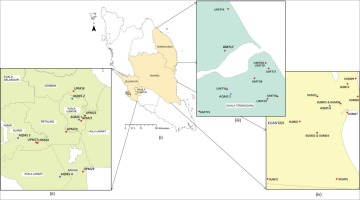
Table 1 provides a summary of the sociodemographic and smoking characteristics of the 27 study participants. The majority of participants from Terengganu and Pahang were from the ‘bottom 40%’ (B40) of the Malaysian national income category, with monthly household income ranging from less than <2500 to 4849 MYR (where 1 MYR=0.24 US$, April 2022, estimation at this point of time; 588.65–1141.75 US$) per month. In the Klang Valley, participants came from the ‘middle 40%’ (M40) income bracket, with monthly household income ranging from 4850 to 10959 MYR (589–1142 US$). The majority of participants were male (89%, n=24) and aged 25–44 years (59%, n=16) while 33 % (n=9) were aged >45 years. All participants were of Malay ethnic origin. In terms of education level, 7% (n=2) had attained at least a Bachelor’s degree and more than half of participants had completed secondary school (56%, n=15). More than 50% of participants lived in a house (bungalow) made of brick or stone, a terrace house or a flat, apartment or condominium. Figure 1 shows the sampling locations covered in three areas in the Peninsula of Malaysia.
Table 1
Participant’s sociodemographic and smoking characteristics obtained from an air-quality questionnaire, Klang Valley, Kuantan and Kuala Terengganu, 2021 (N=27)
| Characteristics | n (%) |
|---|---|
| Age (years) | |
| 18–24 | 2 (7.4) |
| 25–54 | 21 (77.7) |
| ≥55–64 | 4 (14.8) |
| Gender | |
| Male | 24 (88.9) |
| Female | 3 (11.1) |
| Ethnicity | |
| Malay | 27 (100) |
| Other | 0 (0) |
| Educational level | |
| Secondary | 15 (55.5) |
| Tertiary | 11 (40.7) |
| Type of house | |
| Bungalow or semi-detached or terraced house made of brick or stone | 16 (59.2) |
| A house made of wood or both brick and wood | 6 (22.2) |
| A flat, apartment or condominium in a purpose-built block of flats | 4 (14.8) |
| A flat, apartment or condominium in a converted or shared house | 1 (3.7) |
| Is smoking allowed inside your home? | |
| Not allowed | 0 (0) |
| Allowed | 2 (7.4) |
| Allowed in certain places only | 19 (33.3) |
| Only allowed when no children are present | 4 (14.8) |
| Only allowed when children are in bed | 1 (3.7) |
| Allowed anywhere in the home | 1 (3.7) |
| Specific indoor areas where smoking is allowed* | |
| Kitchen, dining room and utility room | 6 |
| Attached garage | 6 |
| Balcony | 4 |
| Living room/lounge | 9 |
| Bedroom | 5 |
| Toilet | 4 |
| How many other people smoke in your home? | |
| 0 | 11 (40.7) |
| ≥1 | 16 (59.2) |
The majority of participants were smokers while 15% (n=4) were non-smokers who lived with a smoker. In terms of smoking rules at home, all of the respondents (100%, n=27) reported that smoking was currently permitted in the participant’s home.
Indoor PM2.5 concentrations at baseline and follow-up measurements
All participating households achieved more than 85% data recovery in terms of PM2.5 concentrations at baseline and follow-up (median 100%; 25th percentile 99%; 75th percentile 100%) (Supplementary file Table 1).
Table 2 shows the indoor and outdoor PM2.5 concentrations and the calculated SHS-PM2.5 concentration for baseline and follow-up measurements in the homes of the 27 participants who completed both baseline and follow-up. The range of indoor PM2.5 concentration during baseline measurement was 12.3–140 μg/m3 (Klang Valley 30.7–107 µg/m3; Terengganu 25.1–71.5 µg/m3; Pahang 12.3–140 µg/m3), while the follow-up concentrations ranged from 15.8–84.1µg/m3 (Klang Valley 19.4–62 µg/m3; Terengganu 20.7–84.1 µg/m3; Pahang 15.8–68.9 µg/m3]. Using the unadjusted data of indoor PM2.5 (unadjusted for outdoor PM2.5 concentration), the changes of indoor PM2.5 concentrations within baseline and follow-up measurements were not statistically significant (Z= -1.27, p=0.20) with the median of baseline PM2.5 concentrations being 38.9 µg/m3 and at follow-up 32.9 µg/m3.
Table 2
Indoor and outdoor PM2.5 concentrations (µg/m3) and SHS-PM2.5 concentrations for baseline and follow-up measurements in participant houses, Klang Valley, Kuantan and Kuala Terengganu, 2021 (N=27)
| Participant ID | Baseline | Follow-up | Intervention effect * | Distance of outdoor air quality monitoring station from participant’s house (km) | ||||
|---|---|---|---|---|---|---|---|---|
| PM2.5 (Mean ± SD) | SHS-PM2.5 | PM2.5 (Mean ± SD) | SHS-PM2.5 | |||||
| Indoor | Outdoora | Indoor | Outdoora | |||||
| UPM21 | 37.8 ± 32.3 | 23.7 ± 10.9 | 14.0 | 26.3 ± 27.0 | 22.4 ± 3.94 | 3.9 | -10.2 | 4 |
| UPM25 | 35.8 ± 60.8 | 17.5 ± 4.13 | 18.3 | 49.8 ± 52.5 | 27.0 ± 6.89 | 22.9 | 4.6 | 8.8 |
| UPM30 | 30.7 ± 25.5 | 16.3 ± 3.68 | 14.4 | 19.4 ± 24.2 | 12.7 ± 6.31 | 6.7 | -7.8 | 14.8 |
| UPM18 | 34.9 ± 24.3 | 21.5 ± 9.56 | 13.3 | 29.7 ± 41.0 | 19.4 ± 6.70 | 10.3 | -3.1 | 6.8 |
| UPM26 | 80.6 ± 88.0 | 32.1 ± 6.54 | 48.6 | 48.0 ± 94.6 | 23.3 ± 5.16 | 24.6 | -24.0 | 14.7 |
| UPM27 | 107.3 ± 100.8 | 49.6 ± 8.4 | 57.8 | 62.0 ± 64.6 | 27.8 ± 8.25 | 34.2 | -23.6 | 13.8 |
| UPM29 | 41.0 ± 112.4 | 19.5 ± 6.13 | 21.5 | 46.3 ± 174.8 | 14.8 ± 5.53 | 31.6 | 10.1 | 19.1 |
| UMT06 | 44.1 ± 31.0 | 46.4 ± 8.89 | -4.26 | 20.7 ± 26.2 | 17.9 ± 7.68 | 2.8 | 7.11 | 5.1 |
| UMT08 | 25.1 ± 26.7 | 16.0 ± 5.42 | 9.1 | 47.1 ± 77.4 | 22.0 ± 8.46 | 25.1 | 16.0 | 2.8 |
| UMT10 | 71.5 ± 83.0 | 41.7 ± 15.1 | 29.8 | 43.2 ± 64.5 | 15.0 ± 5.88 | 28.3 | -1.58 | 5.1 |
| UMT14 | 45.2 ± 72.0 | 11.7 ± 3.41 | 33.4 | 84.1 ± 110.1 | 17.0 ± 6.0 | 67.1 | 33.7 | 10.2 |
| UMT15 | 44.9 ± 62.2 | 23.3 ± 10.1 | 21.6 | 27.8 ± 51.3 | 11.8 ± 6.39 | 15.9 | -5.62 | 5.4 |
| UMT16 | 49.2 ± 56.5 | 24.3 ± 9.60 | 24.9 | 30.3 ± 51.1 | 14.9 ± 9.14 | 15.5 | -9.42 | 1 |
| UMT17 | 49.5 ± 58.4 | 22.2 ± 8.07 | 27.3 | 58.4 ± 63.5 | 32.8 ± 9.37 | 25.6 | -1.70 | 5 |
| UMT18 | 34.1 ± 29.1 | 23.0 ± 7.71 | 11.1 | 27.5 ± 32.1 | 17.1 ± 5.52 | 10.4 | -0.56 | 4.5 |
| UMT19 | 46.2 ± 50.9 | 22.9 ± 8.29 | 23.3 | 47.6 ± 49.3 | 30.5 ± 9.21 | 17.1 | -6.18 | 4.6 |
| UMT20 | 41.6 ± 37.0 | 25.8 ±10.6 | 15.8 | 25.5 ± 33.9 | 15.1 ± 4.88 | 10.4 | -5.43 | 4.4 |
| IIUM01 | 38.4 ± 72.9 | 13.6 ± 7.32 | 24.8 | 30.0 ± 42.9 | 9.30 ± 2.49 | 20.8 | -4.08 | 12.9 |
| IIUM13 | 139.8 ± 118.2 | 13.4 ± 3.43 | 126.4 | 68.9 ± 107.0 | 13.0 ± 2.45 | 55.9 | -70.5 | 13.9 |
| IIUM12 | 24.5 ± 29.8 | 9.32 ± 4.30 | 15.2 | 32.9 ± 19.3 | 19.0 ± 7.52 | 13.9 | -1.31 | 9.5 |
| IIUM11 | 18.7 ± 23.3 | 10.5 ± 3.84 | 8.2 | 34.1 ± 15.9 | 25.0 ± 1.88 | 9.11 | 0.92 | 29.4 |
| IIUM02 | 44.1 ± 68.9 | 10.6 ± 5.96 | 33.5 | 15.8 ± 31.3 | 8.26 ± 2.15 | 7.57 | -25.9 | 13.7 |
| IIUM10 | 23.5 ± 30.9 | 8.88 ± 2.28 | 14.6 | 34.7 ± 38.3 | 18.6 ± 7.59 | 16.1 | 1.45 | 29.5 |
| IIUM08 | 38.9 ± 83.1 | 10.6 ± 2.85 | 28.3 | 36.2 ± 100.3 | 9.51 ± 4.64 | 26.7 | -1.63 | 12.4 |
| IIUM07 | 12.3 ± 28.7 | 6.97 ± 2.77 | 5.3 | 26.6 ± 61.3 | 10.4 ± 2.43 | 16.2 | 10.9 | 8.5 |
| IIUM05 | 27.0 ± 36.1 | 9.02 ± 2.40 | 17.9 | 30.1 ± 37.5 | 8.02 ± 2.21 | 22.1 | 4.14 | 4.2 |
| IIUM09 | 13.9 ± 12.8 | 7.82 ± 2.14 | 6.10 | 24.7 ± 53.9 | 10.7 ± 2.78 | 14.0 | 7.94 | 16.1 |
| Mean ± SD | 44.5 ± 27.7 | 19.9 ± 11.5 | 24.5 ± 24.2 | 38.1 ± 16.2 | 17.5 ± 6.92 | 20.5 ± 14.5 | -3.68 ± 18.1 | 10.4 ± 7.3 |
| Median (IQR difference) | 38.9 (16.9) | 17.5 (12.9) | 18.3 (14.2) | 32.9 (20.3) | 17 (9.95) | 16.2 (15.0) | -1.63 (12.4) | 8.8 (9.3) |
| Range | 12.3–139.8 | 6.97–49.6 | -4.26–126.4 | 15.8–84.1 | 8.02–30.5 | 3.9–67.1 | -70.5–33.7 | 1–29.4 |
Compared with the Malaysian ambient air-quality standard for PM2.5 (35 µg/m3) (DOE, 2018), 63% (n=17) of participants experienced indoor baseline PM2.5 concentrations that exceeded this recommended value, while only 41% (n=11) exceeded the recommended value of 35 µg/m3 during follow-up measurement. Using the newly established WHO Air Quality guideline for 24-h average PM2.5 (15 µg/m3), 93% (n=25) of participants’ homes exceeded the recommended value of 15 µg/m3 during baseline measurement with this increasing to 100% (n=27) at follow-up measurement.
Outdoor PM2.5 concentrations at baseline and follow-up measurements
The secondary data of outdoor PM2.5 concentration of particular time period were back-calculated from the API values obtained from the DOE as reported in Table 2. Generally, the range of hourly outdoor PM2.5 concentrations during the baseline measurement was 6.97–49.6 µg/m3 (Klang Valley 16.3–49.6 µg/m3; Terengganu 11.7–48.4 µg/m3; Pahang 6.97–13.6 µg/m3) with an overall mean (SD) of 20.0 (11.6) µg/m3 [Klang Valley 25.7 (11.7) µg/m3; Terengganu 25.9 (11.02) µg/m3; Pahang 10.1 (2.16) µg/m3]. For follow-up measurement, the range of outdoor PM2.5 concentration was 8.02–30.5 µg/m3 (Klang Valley 12.7–27.8 µg/m3; Terengganu 11.8–32.8 µg/m3; Pahang 8.02–24.9 µg/m3) with overall mean (SD) of 17.5 (6.92) µg/m3 [Klang Valley 21.1 (5.77) µg/m3; Terengganu 19.4 (6.98) µg/m3; Pahang 13.2 (5.73) µg/m3].
In terms of intervention effect, the finding shows that there was a reduction of SHS-PM2.5 concentration in the follow-up measurements in 17 participant houses (63%) indicated by a negative value.
Corrected indoor PM2.5 concentrations representative of SHS-PM2.5 level
Figure 5 shows the corrected indoor PM2.5 concentrations (SHS-PM2.5) at baseline and follow-up measurements. The median (IQR) SHS-PM2.5 concentrations at baseline and follow-up were 18.3 µg/m3 (13.3–28.3) and 16.2 µg/m3 (10.4–25.6), respectively. A total of 17 participant houses exhibited lower concentration of SHS-PM2.5 at follow-up measurement than at baseline, while another 10 participant houses showed an increase in SHS-PM2.5 concentration at follow-up. Overall, the change in corrected indoor PM2.5 concentrations between baseline and follow-up was not statistically significant (Z= -1.01, p=0.29).
Figure 5
Corrected SHS-PM2.5 concentrations (µg/m3) at the baseline and follow-up measurements in 27 participants’ houses located in the Klang Valley, Kuantan and Kuala Terengganu. Dashed line shows identity (x=y) with points to the right of the line indicative of homes that experienced reduced concentrations after follow-up, and homes to the left of that line indicating an increase (2021, N=27)
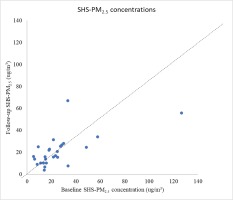
Reported number of cigarettes smoked indoors
A total of four participants submitted incomplete smoking diaries at either baseline or follow-up. Using the data from the 23 participants with complete smoking diary data, the mean±SD number of cigarettes smoked indoors during the 7-day baseline and follow-up measurements were 46±36 sticks and 35±39 sticks, respectively. About 61% (n=14) of participants smoked a lower number of cigarettes indoors at follow-up measurement than during the baseline period. However, six (26%) participants smoked indoors more frequently during follow-up than during the baseline measurement. One participant reported no change. A statistically significant change in total number of cigarettes smoked indoors at baseline (median 40) and follow-up (median 26) measurements was demonstrated (Z= -2.436, p=0.015).
DISCUSSION
This study demonstrated the feasibility and practicality of using household air-quality information gained from the use of low-cost devices within an intervention to help promote smoke-free homes in Malaysia. Participants were successfully recruited, data collected and the intervention delivered despite the challenges of carrying out such a household intervention during the COVID-19 pandemic. We used courier delivery services, self-installation by the respondents using specially developed booklets and videos, and delivered the educational intervention through a combination of post and phone. A similar approach of using air-quality feedback to encourage smoke-free homes have been applied in previous studies9,10,19, which were mainly conducted in European countries. Compared with the current study, the previous works have used different mediums of feedback communication such as SMS messages and emails10 and in person sessions19 to deliver the air-quality feedback to the participants. This is the first study in Malaysia that has used this approach to promote smoke-free home’s implementation.
Measuring PM2.5 in smoking households with the Purple Air in Malaysia
This is the first study performed in Malaysian homes that measured real-time indoor PM2.5 concentrations using the PA-II-SD device, a low-cost particle counter, and the first to provide personalized air-quality feedback with the aim of reducing smoking in the home. This study found that the device is suitable for measuring indoor PM2.5 for this purpose, as has been demonstrated in other recent studies20-24. The indoor SHS-PM2.5 concentrations reported in this current study were generally lower than the levels reported in previous studies performed in European countries10,19, with the median of 18.3 µg/m3 [vs 33.0 µg/m3 (Dobson et al.10) and 48.2 µg/m3 (Semple et al.19)] (baseline) and 16.2 µg/m3 [vs 33.0 µg/m3 (Dobson et al.10] (follow-up). The differences in home setting in Malaysia and European countries is likely to explain some of the differences in SHS-PM2.5. Generally, in the temperate climate United Kingdom, homes are built to be energy saving and as such the number of air changes per hour tends to be smaller than in homes in the tropical Malaysian setting. Homes in Malaysian will often have open windows or doors or be air-conditioned, leading to high levels of dilution ventilation.
Efficacy and acceptability of the intervention
This was a first study performed in Malaysian household setting that incorporated the data of PA-II-SD into the educational intervention to encourage SFH implementation. This feasibility study did not set out to address the efficacy of this intervention and this is for future researchers to study. The study was unsuitable for this purpose due to its small sample size, the variability in feedback-delivery sessions between centers and the short period of follow-up measurement. The MCO resulted in more people spending more time at home, so the extent to which this intervention could reduce exposure to SHS-PM2.5 might be obscured by high emissions of PM2.5 from other non-smoking sources.
However, a small reduction of SHS-PM2.5 concentrations ranging from 5.29% to 77% were shown in nearly two-thirds of participant homes (63%; n=17). This was in line with the significant reduction of total number of cigarettes smoked indoor reported by more than half of participants (54%) in the follow-up measurement. These reductions in SHS-PM2.5 concentrations in the smokers’ homes suggests there is potential to have impact with this type of the intervention in Malaysia.
Strengths and limitations
The major strength of this study is the range of components included. This study provided real-time PM2.5 data to the participants demonstrating the impact of smoking on the indoor air quality of their houses. The personalized-evidence illustrated in the air-quality feedback can lead to the behavior change of smokers in reducing indoor smoking habit25,26 and encouraging action to introduce smoke-free home rules9. Thus, the comprehensive and active approach adopted in this study was able to translate the scientific evidence into public health action.
Limitations of this study include the use of PM2.5 as an indicator of secondhand smoke exposure. There are other potential sources of indoor PM2.5 emitted from household activities such as cooking, sweeping, use of candles and ambient air pollution. We have addressed this last concern by comparing indoor to outdoor PM2.5 from a nearby monitoring station, and the other concerns through the use of smoking diaries (used during feedback). Unreliable or incomplete diary use may, however, form another source of potential error.
Furthermore, the COVID-19 pandemic created challenges in terms of delivering an intervention to the respondents. Due to the Movement Control Order (MCO) in Malaysia, physical visits to participants’ houses were restricted. Therefore, adjustments to the research protocol were made. The device toolbox packages and personalized air-quality feedback documents were sent via instant delivery services. Participants installed the devices at home by referring to a booklet and video as a guide. In order to ensure the device was correctly installed, participants were requested to take a picture of the device to be sent to the researchers and participants were encouraged to contact the researchers throughout the sampling period if they had any questions. However, some participants did not turn the monitors on immediately after receiving them. Due to that limitation, four households did not reach the minimum seven days of measurements. Therefore, follow-up procedures are recommended in further studies to improve compliance.
The majority of feedback delivery sessions were performed virtually via phone call. This contrasts with previous studies, where intervention delivery was either in person (face-to-face)19, and/or by SMS and email10. To make the sessions more effective and impactful, the personalized air-quality feedback documents were provided to participants before the session to ensure that participants could access the documents in hard-copy while speaking on the phone.
Another limitation of the intervention portion of this study was variation in feedback delivery between the three research centers. This arose due to changes in the feedback template adopted in one center which were not adopted in the other two. While this may affect efficacy, it provides a valuable opportunity to study the acceptability of different methods of providing feedback.
The need for publicly available real-time data in Malaysia
Ambient PM2.5 data were not publicly available in the official website of DOE. Therefore, back-calculation of API values on particular sampling time and date were performed in order to generate the ambient PM2.5 concentration data. These data were important for the research team to understand the relative contribution of smoking to indoor PM2.5 compared to outdoor air pollution. Therefore, this study suggests the importance of making ambient PM2.5 data publicly accessible in Malaysia. This is common practice in the United Kingdom27 and the US28. API data cannot always be back-calculated to PM2.5 (if, for example, the primary ambient pollutant is ozone) so, it is important that real-time PM2.5 data are freely available to researchers in Malaysia.
CONCLUSIONS
This study demonstrated the feasibility of delivering an air-quality feedback intervention to smoking-permitted households in Malaysia. The work provides details of practical measures to facilitate delivery of such an intervention, with significant learning arising from having to deliver the study during the movement restrictions imposed during the COVID-19 pandemic. Although the intervention was delivered remotely, the intervention using personalized air-quality feedback shows potential to trigger behavior change among smokers, particularly in relation to their indoor smoking habit. Using this study’s protocol, future research should be carried out on a large number of smokers with longer follow-up in order to study the efficacy of this intervention.

